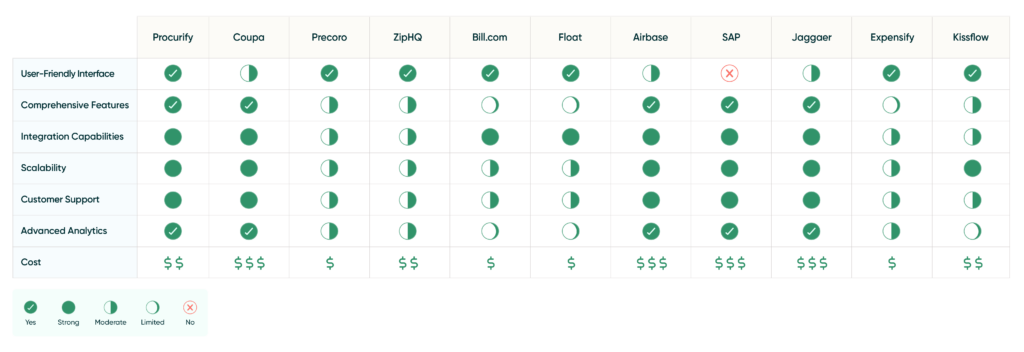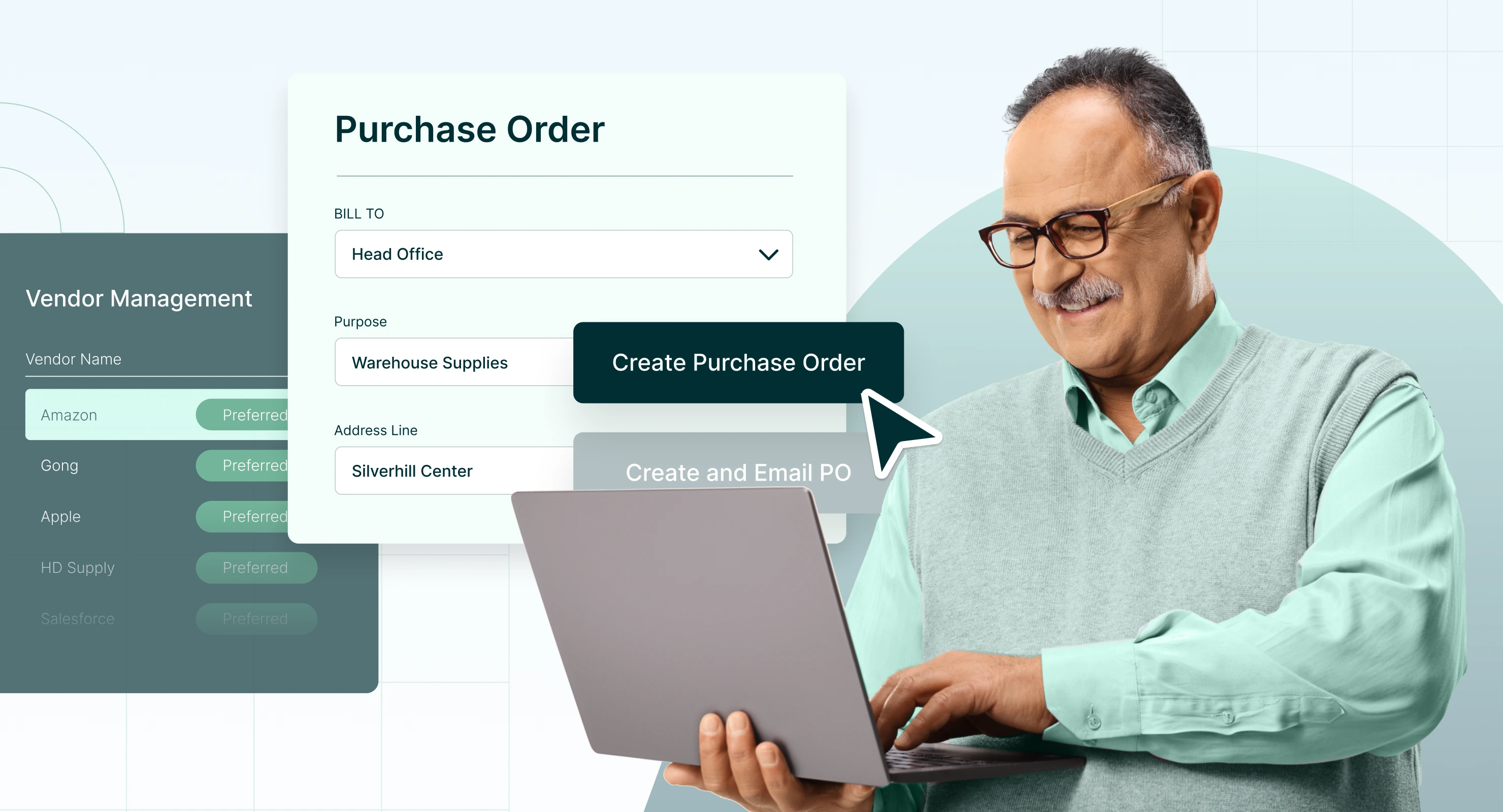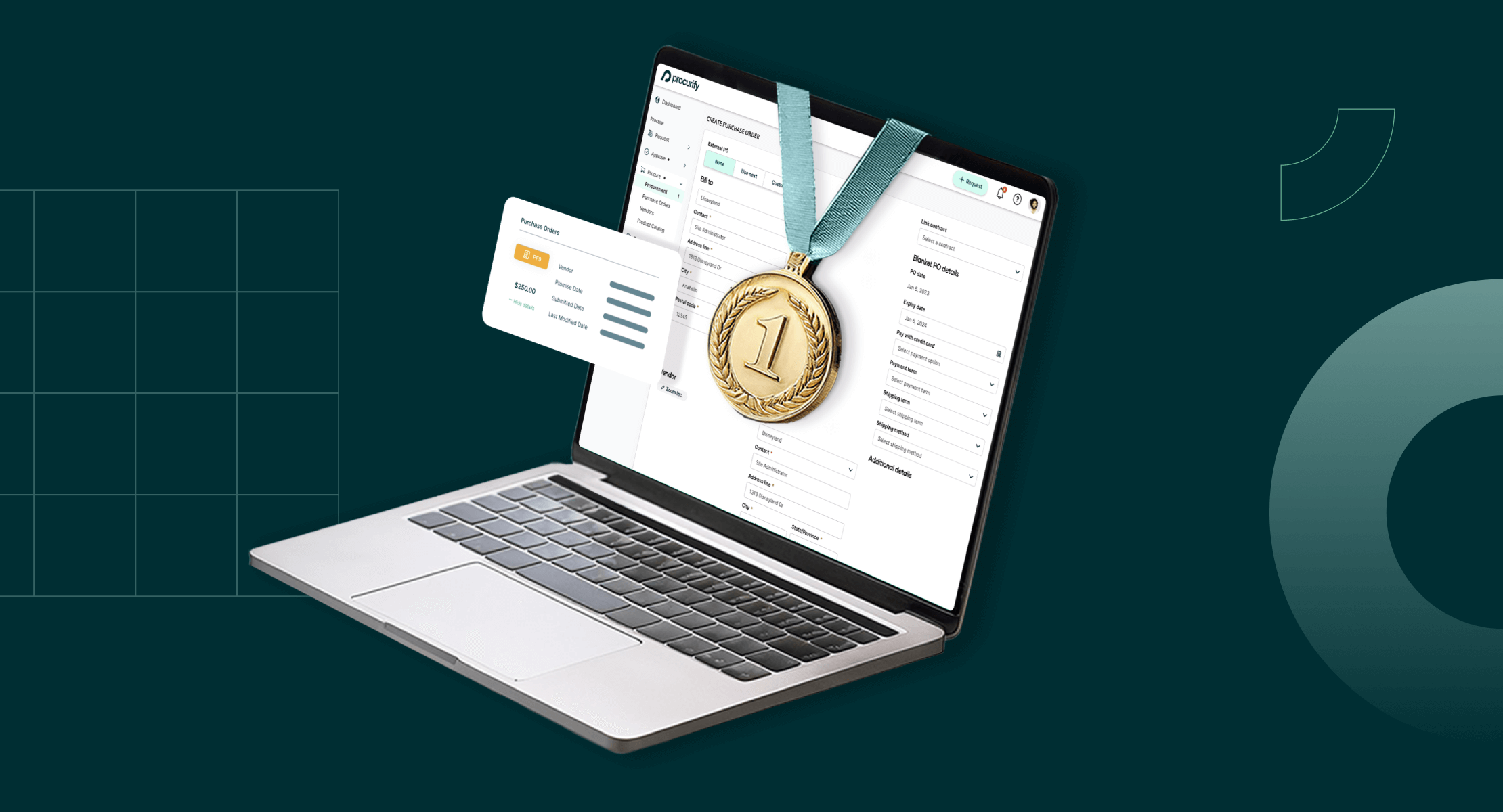
Best Procurement Software: Who’s Winning in 2024?
In the Olympic Games, the difference between winning and losing can come down to a nanosecond, a quarter of an inch, or a single point.
The race for the best procurement software can be just as competitive.
There is a lot at stake for finance teams in medium-sized or enterprise organizations. Efficient procurement processes are vital for maintaining competitive advantage and operational excellence. Procurement software has become an essential tool for businesses, enabling them to streamline purchasing, manage supplier relationships, and control costs effectively.
The landscape of procurement software continues to evolve, with new innovations – like AI and machine learning – and features designed to meet the diverse needs of organizations.
This article ranks the top procurement software of 2024, evaluating each platform based on its:
-
Features
-
Ease of use
-
Scalability
-
Overall value
Our comprehensive review includes detailed overviews, the pros and cons of each software, and why certain aspects matter. Our goal is to help businesses make informed decisions by highlighting the strengths and weaknesses of the top contenders. Without further ado, let’s dive into the best procurement software of 2024 and see who comes out with the gold!
Detailed reviews of the top procurement software
Procurify - The best procurement software winner
Overview
Procurify stands out as a leading procurement software solution, designed to simplify and streamline procurement processes for businesses of all sizes. With a user-friendly interface and robust feature set, Procurify has become a go-to platform for companies looking to enhance their purchasing workflows. Procurify is consistently recognized as a market leader in diverse categories on G2 — from purchasing and procure-to-pay to strategic sourcing.
History
Founded with the mission to make business spending smarter, Procurify has grown rapidly, continually innovating to meet the evolving needs of its users. The software has established itself as a trusted solution in the market, known for its reliability and customer-centric approach.
Pros
-
User-friendly interface: Procurify’s intuitive design makes it easy for users to navigate the platform, reducing the learning curve and increasing adoption rates. This accessibility ensures that all team members, regardless of technical expertise, can efficiently manage procurement tasks.
-
Comprehensive features: The software offers a wide range of features, including budgeting, spend management, purchase order management, and approval workflows. These capabilities provide end-to-end control over the procurement process, from requisition to payment.
-
Scalability: Whether you’re a small business or a large enterprise, Procurify scales seamlessly to meet your needs. Its flexible pricing and modular features allow companies to grow without outgrowing the platform.
-
Integration capabilities: Procurify integrates smoothly with popular ERP and accounting systems, such as QuickBooks, NetSuite, and Xero. This ensures a unified flow of data across systems, minimizing errors and improving efficiency.
-
Customer support: Procurify is renowned for its responsive and helpful customer support. The company offers comprehensive onboarding and training resources, as well as ongoing support to ensure users maximize the software’s potential.
Cons
-
Limited in-app reporting: Some users might find the basic reporting options insufficient, however, data can be exported to do more in-depth reporting if needed.
-
Procurify has limited offline capabilities which means that users will need an internet connection to use the software.
-
Procurify’s mobile app offers fewer features compared to the web version, but the most critical procurement features are available on mobile, making it the highest-rated procurement application on the market.
Why Procurify wins
Procurify’s strengths lie in its balance of user-friendliness, comprehensive features, and scalability. Compared to competitors like Coupa, ZipHQ, and Precoro, Procurify excels in offering a more accessible and affordable solution without compromising on functionality. The platform’s strong integration capabilities and exceptional customer support further solidify its position as the top choice for businesses in 2024. For companies looking for a dependable, feature-rich procurement solution that can grow with them, Procurify is the clear winner.
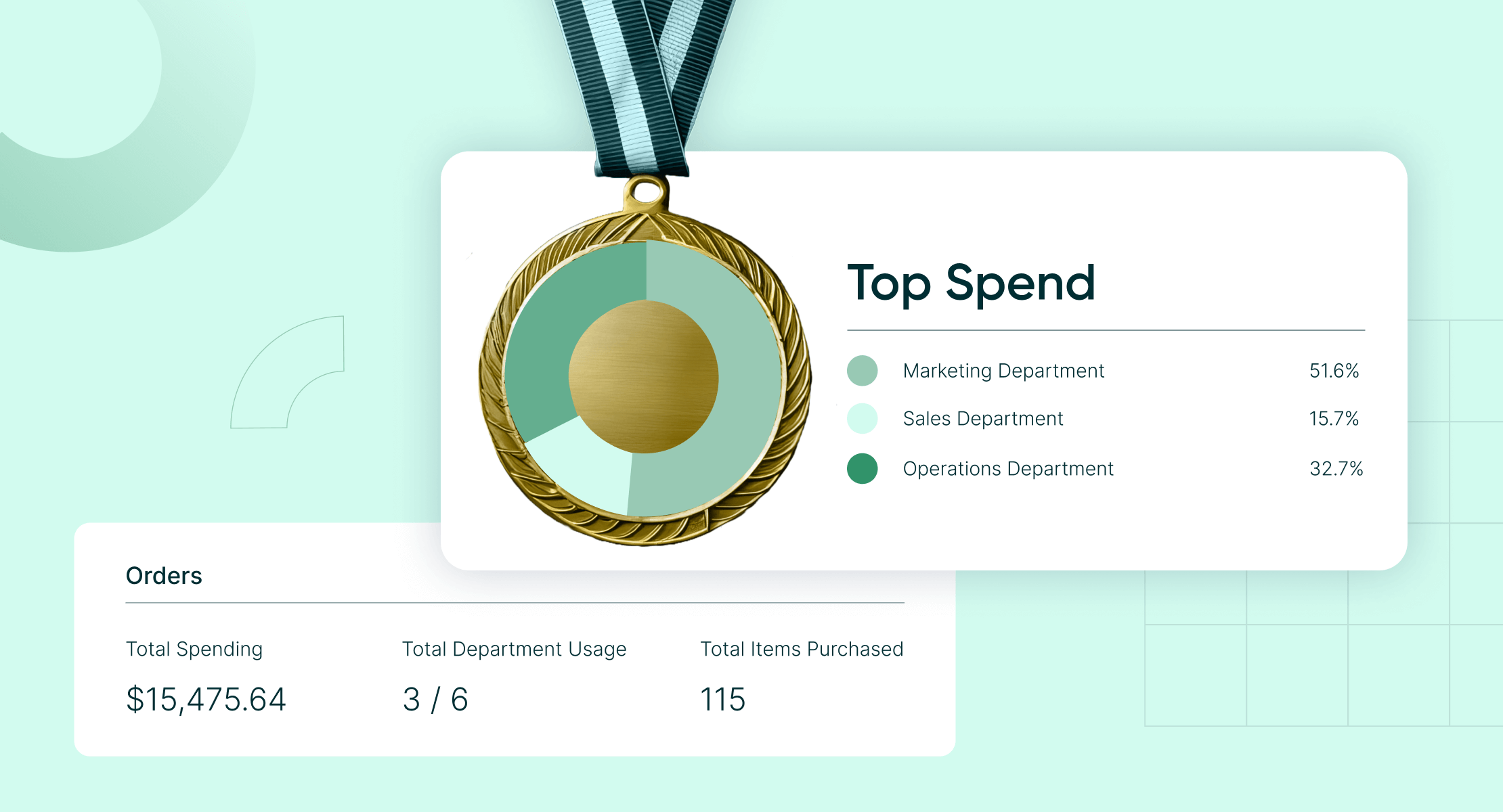
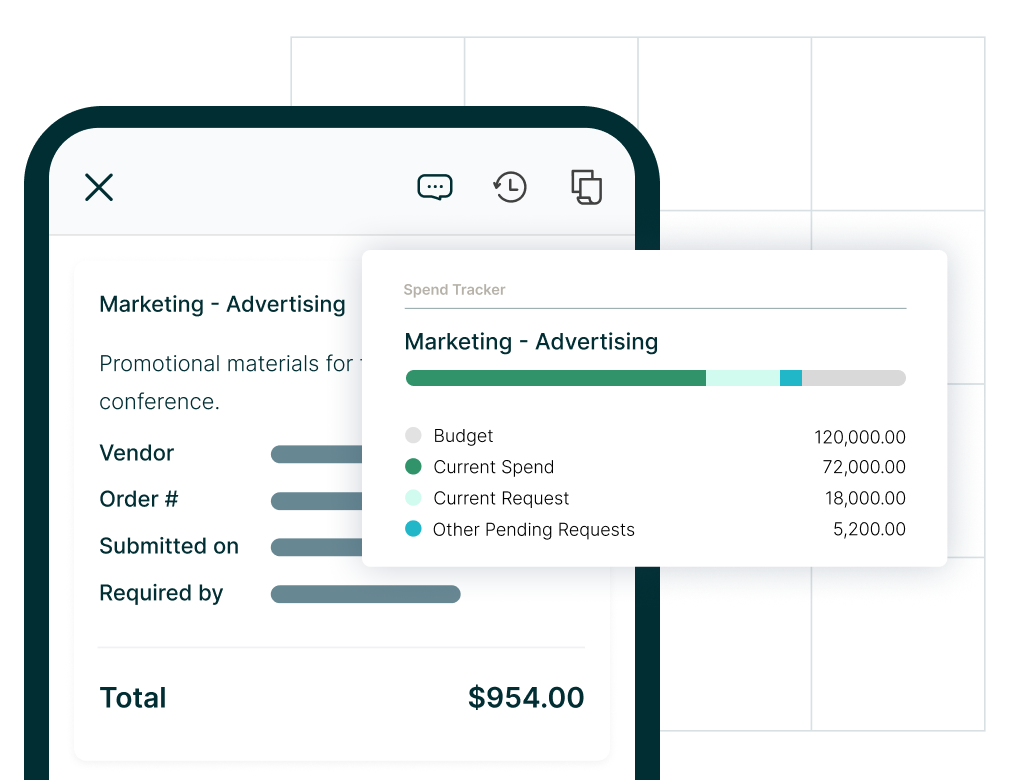
Experience the top procurement software for yourself
Ready to transform your procurement process? Book a demo today and see how Procurify’s procurement software can help your team work smarter, not harder.
Coupa
Overview
Coupa is a robust procurement software solution known for its comprehensive suite of features. It is designed to help businesses manage their procurement, invoicing, and expense management processes efficiently.
History
Founded in 2006, Coupa has grown to become a leader in the business spend management space. The company has continuously expanded its offerings through innovation and strategic acquisitions, solidifying its position in the market.
Pros
-
Comprehensive suite: Coupa offers an extensive range of features, covering procurement, invoicing, expense management, and more. This makes it a one-stop solution for businesses looking to manage their entire spend lifecycle.
-
Global reach: Coupa is well-suited for large, multinational corporations due to its ability to handle complex, global procurement needs. It supports multiple currencies, languages, and compliance requirements.
-
Analytics: The platform provides advanced analytics and reporting capabilities, giving businesses deep insights into their spending patterns and helping them make data-driven decisions.
Cons
-
Complexity: Due to its extensive feature set, Coupa has a steeper learning curve compared to some other solutions. This complexity can make implementation and user adoption more challenging.
-
Cost: Coupa’s robust capabilities come at a higher price point, which may make it less accessible for smaller businesses or those with limited budgets.
Why these pros and cons matter
The importance of having a comprehensive suite for large corporations cannot be overstated. Coupa’s ability to handle complex procurement needs and provide detailed analytics makes it a powerful tool for global businesses. However, the trade-off between advanced features and user-friendliness must be considered, especially for smaller organizations with simpler needs.
Precoro
Overview
Precoro is an efficient procurement tool designed to simplify the purchasing process for small to medium-sized businesses. It offers a straightforward interface and essential procurement features at an affordable price.
History
Founded to make procurement more accessible for smaller businesses, Precoro has focused on delivering value through simplicity and cost-effectiveness. The company has steadily grown its user base by addressing the specific needs of its target market.
Pros
-
Affordability: Precoro’s competitive pricing makes it an attractive option for small to medium-sized businesses looking to streamline their procurement processes without a significant investment.
-
Ease of use: The platform’s simple and straightforward interface ensures that users can quickly get up to speed and start managing their procurement activities efficiently.
-
Features: Despite its simplicity, Precoro offers a good range of essential procurement features, including purchase order management, approval workflows, and budgeting.
Cons
-
Advanced features: Precoro lacks some of the advanced features and customization options found in higher-end solutions, which might be necessary for larger or more complex organizations.
-
Integration: The platform’s integration capabilities are limited compared to top competitors, which can be a drawback for businesses needing seamless data flow across multiple systems.
Why these pros and cons matter
The affordability and ease of use offered by Precoro are significant advantages for smaller businesses. These features make it possible to improve procurement efficiency without the complexity and cost associated with more comprehensive solutions. However, businesses with more advanced needs or those requiring extensive integrations may find Precoro’s limitations challenging.
ZipHQ
Overview
ZipHQ is a modern procurement solution focused on delivering innovative features and a user-friendly experience. It is designed to enhance team collaboration and streamline procurement processes.
History
ZipHQ is a relatively new entrant in the procurement software space, but it has quickly gained recognition for its modern approach and emphasis on innovation. The company has been growing rapidly by catering to businesses looking for fresh and intuitive solutions.
Pros
-
Innovation: ZipHQ stands out for its modern, innovative features that aim to simplify and enhance procurement activities.
-
User experience: The platform places a strong emphasis on a clean, intuitive user interface, making it easy for users to navigate and perform tasks efficiently.
-
Collaboration tools: ZipHQ offers enhanced tools for team collaboration, allowing for more streamlined communication and workflow management.
Cons
-
Maturity: As a newer player in the market, ZipHQ may lack some of the more established features and reliability of older, more mature software.
-
Scalability: While suitable for small to medium-sized businesses, ZipHQ may face challenges in scaling to meet the needs of very large enterprises.
Why these pros and cons matter
The benefit of innovative features and a strong user experience can significantly enhance procurement efficiency and user satisfaction. However, businesses need to weigh these advantages against the potential limitations in scalability and maturity when considering ZipHQ.
Bill.com
Overview
Bill.com is a financial operations platform that focuses on automating accounts payable (AP) and accounts receivable (AR) processes. While not a full-fledged procurement solution, it offers valuable features for financial management.
History
Bill.com was founded in 2006 with the goal of simplifying and automating financial operations for businesses. Over the years, it has become a popular choice for managing payables and receivables efficiently.
Pros
-
Automation: Bill.com excels at automating AP and AR processes, reducing manual work and minimizing errors. Its automation features streamline invoice processing and payment workflows.
-
Integration: The platform integrates seamlessly with popular accounting software such as QuickBooks, Xero, and NetSuite, ensuring smooth data flow and consistency across systems.
-
User interface: Bill.com offers an intuitive and easy-to-navigate interface, making it accessible for users with varying levels of technical expertise.
Cons
-
Limited procurement features: While excellent for financial operations, Bill.com lacks the comprehensive procurement capabilities found in dedicated procurement software.
-
Scalability: The platform is well-suited for small to medium-sized businesses but may not scale effectively for very large enterprises with complex procurement needs.
Why these pros and cons matter
Automation and integration capabilities are crucial for improving efficiency and accuracy in financial operations. However, businesses with comprehensive procurement needs may find Bill.com’s features insufficient for end-to-end procurement management.
Float
Overview
Float is a cash flow forecasting and management tool designed to help businesses maintain healthy cash flow and financial stability. While not specifically a procurement tool, it plays a critical role in financial planning.
History
Founded in 2011, Float has carved out a niche by providing robust cash flow management solutions. It integrates with popular accounting software to offer real-time insights into cash flow.
Pros
-
Cash flow management: Float excels in budgeting and forecasting cash flow, helping businesses maintain financial stability and plan for future expenses.
-
Integration: The platform integrates well with accounting software such as QuickBooks, Xero, and FreeAgent, providing seamless data synchronization.
-
User-friendly: Float is known for its easy setup and intuitive interface, making it accessible for users without extensive financial expertise.
Cons
-
Procurement limitations: Float is not a comprehensive procurement solution and lacks features such as purchase order management and supplier management.
-
Feature set: Its functionality is limited to cash flow management, which may not meet the needs of businesses looking for a broader procurement tool.
Why these pros and cons matter
Effective cash flow management is essential for financial health, and Float’s capabilities in this area are valuable. However, businesses with specific procurement requirements will need to complement Float with other procurement tools.
Airbase
Overview
Airbase is a spend management platform that covers spend management, accounts payable, and expense management. It aims to provide businesses with real-time visibility and control over their spending.
History
Founded in 2018, Airbase has quickly gained traction in the spend management space. It combines expense management, bill payments, and corporate card management into a single platform.
Pros
-
Comprehensive spend management: Airbase offers an all-in-one solution for managing expenses, bills, and corporate cards, providing a holistic view of business spending.
-
Real-time visibility: The platform offers real-time insights into spending, enabling businesses to make informed financial decisions.
-
Integration: Airbase integrates with major accounting systems like QuickBooks, NetSuite, and Xero, ensuring seamless data flow and financial reporting.
Cons
-
Complexity: Due to its comprehensive feature set, Airbase can be complex to implement and use, requiring a higher level of expertise and resources.
-
Cost: Airbase’s pricing may be higher compared to simpler, more specialized tools, which can be a consideration for smaller businesses.
Why these pros and cons matter
The advantage of comprehensive spend management is significant for businesses looking to streamline their financial operations. However, the complexity and cost associated with such a robust platform may not be justified for all businesses, particularly smaller ones with simpler needs.
SAP
Overview
SAP is a comprehensive enterprise resource planning (ERP) solution known for its extensive range of features and capabilities. It is widely used by large enterprises to manage various business processes, including procurement.
History
Founded in 1972, SAP has grown to become one of the largest and most established ERP vendors in the world. Over the years, it has developed a suite of integrated applications to support business operations across different industries.
Pros
-
Integration: SAP offers seamless integration with a wide range of business processes, providing a unified platform for managing procurement, finance, HR, and more.
-
Scalability: SAP is ideal for large enterprises due to its ability to handle complex, large-scale operations. It supports multiple currencies, languages, and compliance requirements.
-
Advanced features: SAP provides an extensive range of features, including supplier management, contract management, and advanced analytics.
Cons
-
Complexity: The platform has a steep learning curve and can be complex to implement and manage, requiring significant resources and expertise.
-
Cost: SAP is one of the more expensive solutions on the market, which may be prohibitive for smaller businesses.
Why these pros and cons matter
The ability to integrate various business processes and scale to meet the needs of large enterprises makes SAP a powerful tool for complex organizations. However, its complexity and cost may be barriers for smaller businesses or those with simpler needs.
Jaggaer
Overview
Jaggaer is a procurement software solution that offers a comprehensive suite of tools for managing procurement, sourcing, and supplier relationships. It is designed to meet the needs of both public and private sector organizations.
History
Founded in 1995, Jaggaer has established itself as a leader in the procurement software market. The company has continually expanded its offerings through innovation and strategic acquisitions.
Pros
-
Comprehensive procurement suite: Jaggaer offers extensive features, including e-procurement, supplier management, contract management, and spend analytics. This makes it a robust solution for end-to-end procurement management.
-
Analytics: The platform provides strong analytics and reporting capabilities, helping businesses gain insights into their spending patterns and make data-driven decisions.
-
Customization: Jaggaer is highly customizable, allowing businesses to tailor the software to their specific needs and processes.
Cons
-
Complexity: Due to its wide range of features and customization options, Jaggaer can be complex to set up and manage, requiring a higher level of expertise.
-
Cost: The comprehensive capabilities of Jaggaer come at a higher price point, which may be less suitable for smaller businesses.
Why these pros and cons matter
The advantage of a comprehensive procurement suite is significant for businesses looking to manage all aspects of procurement in one place. However, the complexity and cost associated with such a robust platform may be challenging for smaller businesses or those with limited resources.
Expensify
Overview
Expensify is an expense management tool designed to help businesses streamline the process of tracking and reimbursing employee expenses. It offers a user-friendly interface and a robust set of features for managing expenses on the go.
History
Founded in 2008, Expensify has grown rapidly by focusing on simplifying expense management for businesses of all sizes. It is widely used by companies to automate the expense reporting process and improve financial efficiency.
Pros
-
Expense management: Expensify excels in managing employee expenses, offering features such as receipt scanning, expense tracking, and automatic approval workflows.
-
User experience: The platform is known for its easy-to-use interface, which simplifies the expense reporting process for employees and administrators alike.
-
Mobile app: Expensify offers a robust mobile application that allows users to manage expenses on the go, making it highly convenient for business travelers.
Cons
-
Procurement features: While excellent for expense management, Expensify lacks comprehensive procurement capabilities, making it less suitable for businesses looking for an all-in-one procurement solution.
-
Scalability: Expensify is better suited for small to medium-sized businesses, and may not scale effectively for very large enterprises with complex procurement needs.
Why these pros and cons matter
Efficient expense management is crucial for financial control, and Expensify’s capabilities in this area are valuable. However, businesses with broader procurement requirements will need to complement Expensify with other tools to manage end-to-end procurement processes.
Kissflow
Overview
Kissflow is a workflow and process automation platform designed to help businesses streamline their operations. While not specifically a procurement tool, it offers strong capabilities for automating various business processes, including procurement workflows.
History
Founded in 2012, Kissflow has grown to become a popular choice for businesses seeking to automate and optimize their workflows. The platform supports a wide range of applications, from HR to procurement.
Pros
-
Process automation: Kissflow excels at automating workflows and processes, enabling businesses to streamline their procurement activities and reduce manual work.
-
User interface: The platform offers an intuitive and easy-to-navigate interface, making it accessible for users with varying levels of technical expertise.
-
Customization: Kissflow is highly customizable, allowing businesses to tailor workflows and processes to their specific needs.
Cons
-
Procurement specificity: While it offers strong process automation capabilities, Kissflow is not specifically designed for procurement and may lack some of the specialized features found in dedicated procurement software.
-
Complexity: Customization can add to the complexity of setting up and managing the platform, requiring a higher level of expertise and resources.
Why these pros and cons matter
The ability to automate workflows is crucial for improving efficiency and reducing manual errors. However, businesses with specific procurement needs may find that Kissflow’s general-purpose approach lacks some of the specialized features required for comprehensive procurement management.
Other notable mentions
SAP Ariba
-
Overview: SAP Ariba is an established player in the procurement software market, offering a comprehensive suite of procurement solutions.
-
Pros: Extensive features, strong integration capabilities, and support for global procurement needs.
-
Cons: High cost and complexity, making it more suitable for large enterprises.
GEP SMART
-
Overview: GEP SMART is a cloud-based procurement software known for its strong focus on AI and advanced analytics.
-
Pros: Innovative AI features, robust analytics, and comprehensive procurement capabilities.
-
Cons: Higher learning curve and cost, which may be challenging for smaller businesses.
Ivalua
-
Overview: Ivalua is a flexible procurement platform known for its high level of customization.
-
Pros: Highly customizable, strong supplier management features, and extensive procurement capabilities.
-
Cons: Complexity and significant setup requirements, which can be a barrier for businesses with limited resources.
Key features to look for in the best procurement software
When selecting procurement software, it’s critical to understand the key features that will provide the most value to your organization. Here are the top features to look for:
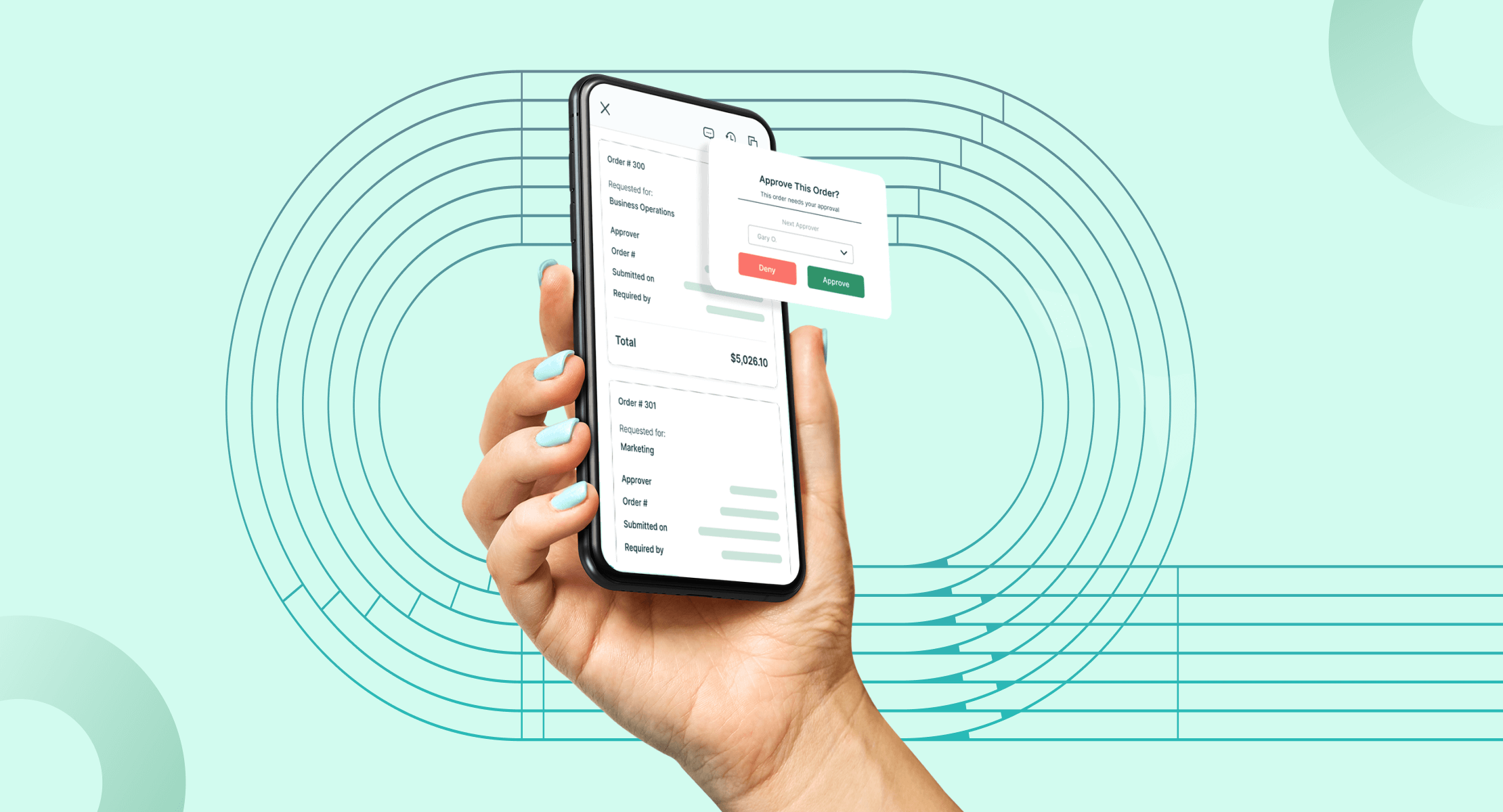
Spend management
-
Importance: Centralized control over spending ensures better budget adherence and cost savings.
-
Functionality: Real-time tracking, analytics, and reporting of expenditures.
Supplier management
-
Importance: Efficient management of supplier relationships can lead to better pricing and more reliable supply chains.
-
Functionality: Supplier information databases and communication tools.
Purchase order management
-
Importance: Streamlined purchase order processes reduce errors and speed up procurement cycles.
-
Functionality: Automated creation, approval, and tracking of purchase orders.
Approval workflows
-
Importance: Customized approval workflows ensure compliance with internal policies and control over spending.
-
Functionality: Configurable workflows that automate approval processes based on predefined rules.
Contract management
-
Importance: Effective contract management reduces risks and ensures compliance with contractual terms.
-
Functionality: Centralized repository for contracts, automated alerts for renewals, and compliance tracking.
Analytics and reporting
-
Importance: Data-driven insights help in making informed decisions and optimizing procurement strategies.
-
Functionality: Comprehensive dashboards and customizable reports.
Integration capabilities
-
Importance: Seamless integration with existing systems ensures data consistency and operational efficiency.
-
Functionality: APIs and pre-built connectors for ERP, accounting, and other business systems.
How to choose the best procurement software for your business
Selecting the right procurement software involves evaluating various factors to ensure it meets your specific business needs. Here’s a step-by-step guide:
Evaluate your business size and needs
-
Small to medium-sized businesses: Look for solutions that offer ease of use, affordability, and essential features.
-
Large enterprises: Consider platforms that provide advanced features, scalability, and support for complex procurement processes.
Set a budget
-
Importance: Define a clear budget to narrow down your options and avoid overspending.
-
Considerations: Include costs for implementation, training, and ongoing support.
Assess specific procurement needs
-
Importance: Identify the specific challenges and requirements of your procurement process.
-
Considerations: Features like supplier management, contract management, and analytics might be more critical for some businesses.
Check integration capabilities
-
Importance: Ensure the software integrates smoothly with your existing ERP, accounting, and other business systems.
-
Considerations: Look for platforms with robust APIs and pre-built connectors.
Evaluate user-friendliness
-
Importance: User-friendly software ensures quick adoption and efficient use by your team.
-
Considerations: Demo the software to assess its interface and usability.
Read reviews and testimonials
-
Importance: User feedback can provide insights into the software’s performance and support quality.
-
Considerations: Look for reviews from businesses similar to yours.
Consider vendor support and training
-
Importance: Reliable customer support and comprehensive training can significantly impact the success of software implementation.
-
Considerations: Check the vendor’s support options, training resources, and customer service reputation.
Benefits of using procurement software
Implementing top-notch procurement software can transform your business operations in several ways. Here are the primary benefits:
Cost savings
-
Explanation: Procurement automation and improved procurement processes lead to significant cost reductions.
-
Impact: Reduced manual errors, better supplier negotiations, and optimized spend management contribute to lower operational costs.
Improved efficiency
-
Explanation: Streamlined workflows and automated processes speed up procurement cycles.
-
Impact: Faster purchase order approvals, quicker supplier onboarding, and reduced procurement cycle times enhance overall efficiency.
Better supplier relationships
-
Explanation: Effective supplier management tools help maintain and improve supplier relationships.
-
Impact: Stronger supplier partnerships, improved supplier performance, and better pricing agreements.
Enhanced compliance
-
Explanation: Automated approval workflows and contract management ensure compliance with internal policies and regulatory requirements.
-
Impact: Reduced risk of non-compliance, improved audit trails, and better adherence to contractual terms.
Data-driven decision making
-
Explanation: Advanced analytics and reporting provide valuable insights into procurement activities.
-
Impact: Informed decision-making, optimized procurement strategies, and better forecasting capabilities.
Scalability
-
Explanation: Modern procurement software can scale with your business as it grows.
-
Impact: Flexibility to handle increased procurement volume and complexity without sacrificing performance.
Common challenges solved by procurement software
Procurement software addresses several common challenges faced by businesses. Here are the key challenges and how top solutions resolve them:
Manual errors
-
Solution: Automation of data entry, purchase orders, and approvals reduces the risk of human error.
-
Impact: Improved accuracy and reliability of procurement data.
Lengthy procurement cycles
-
Solution: Streamlined workflows and automated processes speed up procurement activities.
-
Impact: Faster order processing and quicker time-to-market for products.
Lack of visibility
-
Solution: Real-time tracking and comprehensive dashboards provide transparency into procurement activities.
-
Impact: Enhanced visibility into spend, supplier performance, and order status.
Supplier management issues
-
Solution: Centralized supplier databases and performance tracking tools improve supplier management.
-
Impact: Better supplier relationships, improved performance, and more reliable supply chains.
Compliance risks
-
Solution: Automated workflows and contract management ensure adherence to policies and regulations.
-
Impact: Reduced risk of non-compliance and improved audit readiness.
High procurement costs
-
Solution: Spend management tools and supplier negotiation support help control costs.
-
Impact: Lower procurement costs and improved financial performance.
Future trends in top procurement software
The procurement software landscape is continuously evolving. Here are some emerging trends to watch for in 2024:
Artificial intelligence (AI) and machine learning (ML)
-
Explanation: AI and ML are being integrated into procurement software to enhance decision-making and automate complex tasks.
-
Impact: Predictive analytics, automated risk management, and intelligent supplier recommendations.
Blockchain technology
-
Explanation: Blockchain offers a secure and transparent way to handle transactions and verify documents.
-
Impact: Improved security, reduced fraud, and enhanced traceability in the supply chain.
Robotic process automation (RPA)
-
Explanation: RPA automates repetitive tasks, freeing up human resources for strategic activities.
-
Impact: Increased efficiency, reduced errors, and lower operational costs.
Cloud-based solutions
-
Explanation: The shift towards cloud-based procurement software offers scalability, flexibility, and remote access.
-
Impact: Easier updates, lower upfront costs, and enhanced collaboration.
Sustainability and ethical sourcing
-
Explanation: Increasing focus on sustainability and ethical sourcing in procurement practices.
-
Impact: Improved brand reputation, compliance with regulations, and positive environmental impact.
Frequently asked questions (FAQs) about procurement software
Conclusion

When choosing procurement software, it’s essential to evaluate your specific needs, budget, and the complexity of your procurement processes. By considering these factors and the insights provided in this article, businesses can make informed decisions and select the software that best fits their requirements.
In 2024, the procurement software landscape offers a wide range of solutions tailored to meet the diverse needs of businesses. From comprehensive platforms like SAP and Coupa to specialized tools like Expensify and Float, each solution has its unique strengths and weaknesses.
Why Procurify stands out: Procurify emerges as the top choice due to its balance of user-friendliness, comprehensive features, and scalability. It offers robust procurement capabilities without the complexity and high costs associated with some of the more extensive platforms. Its strong integration capabilities and exceptional customer support further enhance its appeal, making it the best procurement software for businesses looking to streamline their procurement processes effectively.
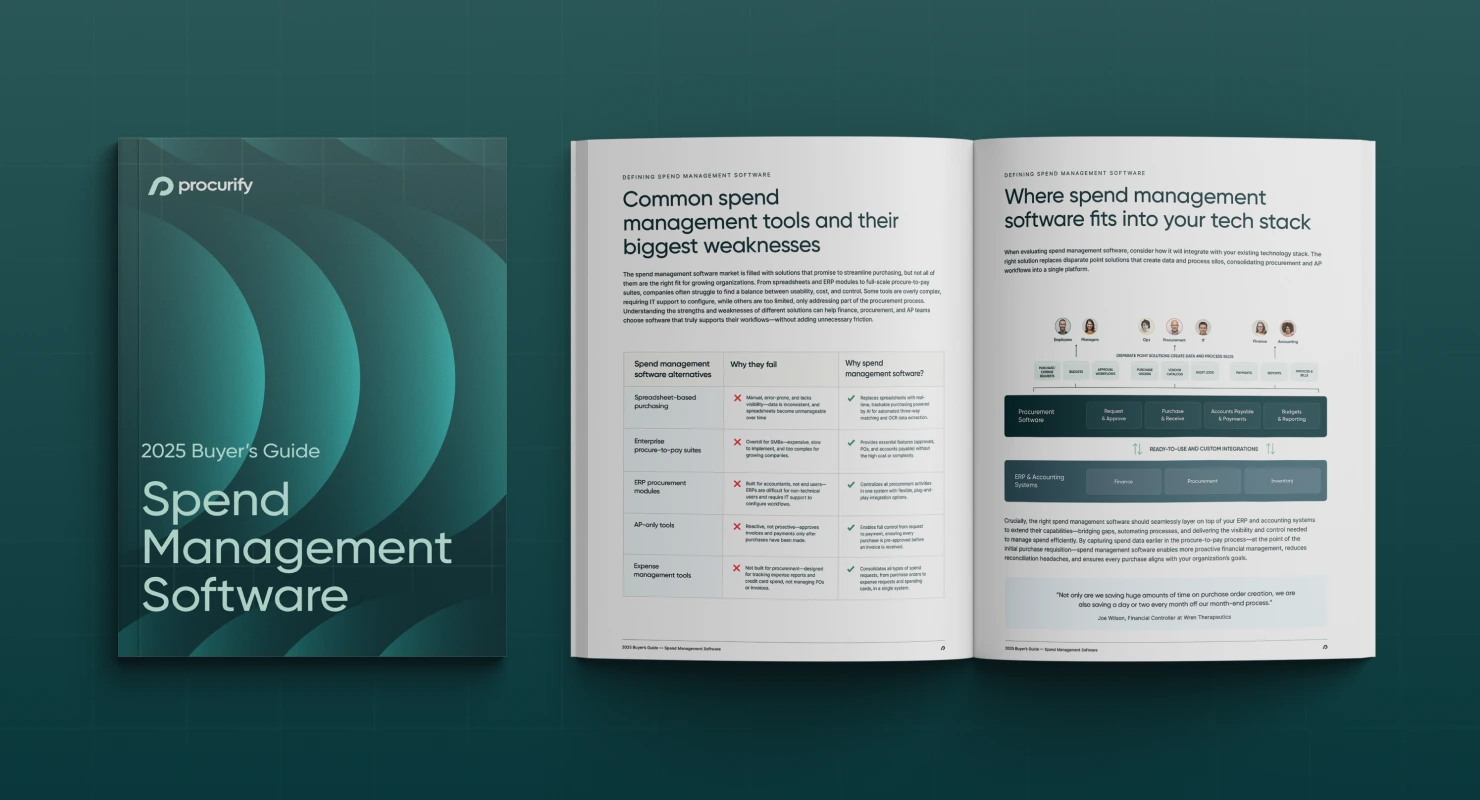
2025 Spend Management Software Buyer’s Guide
Choose the spend management solution best suited to your organization’s needs with an overview of the 2025 software ecosystem, feature comparisons, and a free vendor capability evaluation checklist.

